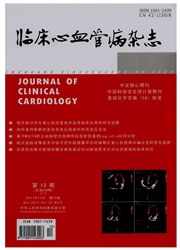

 中文摘要:
中文摘要:
目的:观察缝隙连接激动剂抗心律失常肽(AAP10)对兔长QT综合征(LQTS)模型室性心律失常的影响并探讨其作用机制。方法:应用心肌细胞钠通道开放剂海葵毒素(ATX-Ⅱ,20 nmol/L)在兔左室楔型心肌块建立LQTS模型,随机分为正常组、LQTS组、AAP-100组和AAP-500组,采用浮置玻璃微电极法同步记录心内膜、心外膜心肌细胞跨膜动作电位及跨室壁心电图。通过免疫印迹法(Western blot)反映心肌细胞缝隙连接蛋白43(Cx43)去磷酸化水平的变化。结果:LQTS组QT间期和跨室壁复极离散度(TDR)与正常组相比较显著增大,早期后除极(EAD),R-on-T期前收缩和尖端扭转性室性心动过速(TdP)发生率也显著高于正常组,并伴有Cx43去磷酸化水平增高(均P〈0.01)。在LQTS模拟状态下,AAP-500组QT间期和TDR显著缩短(均P〈0.01),EAD、R-on-T和TdP发生率显著小于LQTS组(P〈0.01、P〈0.01、P〈0.05),并伴随Cx43去磷酸化水平降低(P〈0.01)。结论:缝隙连接激动剂AAP10能通过防止Cx43去磷酸化来减少兔LQTS模型TDR和室性心律失常发生率,说明缝隙连接可能参与了兔LQTS模型TDR的形成。
 英文摘要:
英文摘要:
Objective:To investigate the effect of antiarrhythmic peptide 10(AAP10), a gap junction enhancer, on ventricular arrhythmia in the rabbit ventricular model of long QT syndrome(LQTS). Method: An arterially-perfused rabbit left ventricular preparation and were randomly assigned to control, LQTS, AAP-100 nM and AAP- 500 nmol/L groups. Sea anemone toxin (ATX-Ⅱ , 20 nmol/L) was used to augment the late sodium current and establish a model of LQTS. Transmural ECG and action potentials from both endocardium and epicardium were simultaneously recorded in the whole process of all experiments. Changes of nonphosphorylated connexin 43 (Cx43) were measured by immunoblotting (Western blot). Result:Compared with the control group, the QT interval, TDR, early afterdepolariztion (EAD), R-on-T extrasystole and TdP increased sharply with augmented nonphosphorylated Cx43 in the LQTS group (P〈0.01 for both). Interestingly, compared with the LQTS group, 500 nM AAP10 reduced QT interval, TDR (P〈0.01 for both) and prevented EAD, R-on-T extrasystole and TdP (P〈0.01, P〈0.01, P〈0.05) with a parallel decrease in nonphosphorylated Cx43 in the presence of ATX- Ⅱ (P 〈0.01). Conclusion:Gap junction enhancer AAP10 is capable of reducing TDR and suppressing TdP in a rabbit LQTS model probably by preventing dephosphorylation of Cx43. It is suggested that gap junction at least is partially involved in the generation of TDR in rabbit LQTS models.
 同期刊论文项目
同期刊论文项目
 同项目期刊论文
同项目期刊论文
 期刊信息
期刊信息
